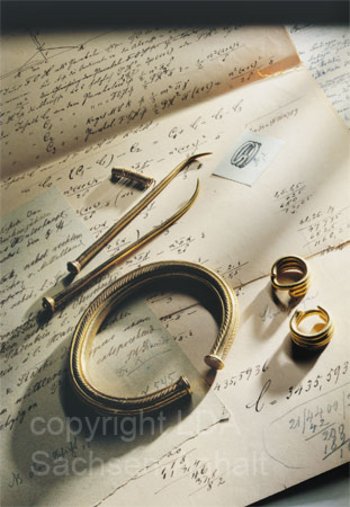The Age of the Sky Disc
The First Chieftains
At the beginning of the Bronze Age (2300 to 1600 BC) in different European regions some individuals were buried very splendidly. They were often buried in huge monuments, provided with lavish gifts.
However, the burial custom only highlights a few prominent figures, women and men. In central Germany around 2000 BC several such chieftains’ graves have been created, including the mound of Leubingen. The power of these dead was based on the wealth of the regions, the control of metal exchange, and also the salt deposits on the Saale.
The time of the magnificent tombs was short. In central Germany, almost two millennia should pass before the archaeological finds reveal similarly important people.
The Wide World in the Heart of Europe
The popularity of amber, copper, tin, and gold at the end of the 3rd millennium BC led to extensive exchange networks for the coveted goods across Europe. Central Germany sat in the heart of Europe like a spider in the web of trade routes between north and south, east and west. In addition, one very exclusive product existed here: salt. Evidence of coarse ceramics in which salt was boiled shows that salt was produced in Halle already in the Early Bronze Age.
Most of the copper processed in central Germany during this period, however, comes from the eastern Alps. Numerous bronzes attest in their shapes and decorations to foreign influences from Ireland, Scandinavia, the Alpine region, and Hungary. At the same time, single central German metal objects have also been recorded in Scandinavia, northern Italy, and Hungary.
Here you can find the films from the »Museum exklusiv« series of the State Museum of Prehistory »Die Himmelsscheibe von Nebra: Aufbruch zu neuen Horizonten« and »Die Himmelsscheibe von Nebra: Gesellschaft ihrer Schöpfer« (German version only).
